Sierra Leone |
|
|
|
| Übersicht – Contents: | |
Diese Seite ist Teil des Projektes
Sierra Leone |
|
|
|
| Übersicht – Contents: | |
Flaggen – Flags: |
|
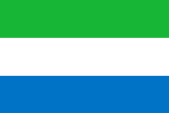 |
National-, Handels-, Staats- und Kriegsflagge – national, merchant, state and war flag, Seitenverhältnis – ratio = 2:3, Quelle/Source, nach/by: Flags of the World   |
 |
Marineflagge – naval flag, Seitenverhältnis – ratio = 2:3, Quelle/Source, nach/by: Flags of the World   |
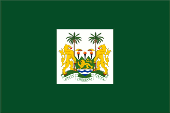 |
Flagge des Präsidenten – flag of the President, Seitenverhältnis – ratio = 2:3, Quelle/Source, nach/by: Flags of the World   |
historische Flaggen – historical Flags: |
|
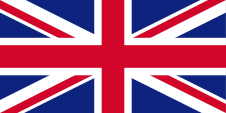 |
1787–1961, Union Flag → quasi Nationalflagge, |
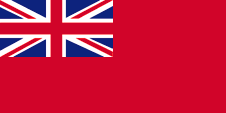 |
1865–1961, |
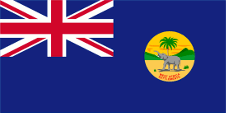 |
1866–1888, Britisch Westafrika, West Africa Settlements, Flagge der Regierung (Staatsflagge) – flag of the government (state flag), Seitenverhältnis – ratio = 1:2, Quelle/Source, nach/by: Wikipedia (DE) |
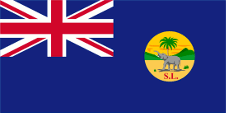 |
1889–1914, |
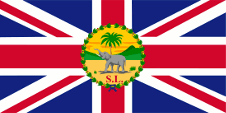 |
1889–1914, Flagge des Gouverneurs – flag of the Governor, Seitenverhältnis – ratio = 1:2, Quelle/Source, nach/by: Flags of the World |
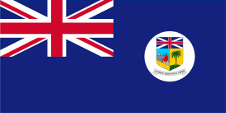 |
1914–1961, |
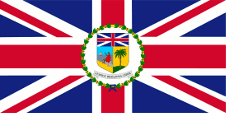 |
1914–1961, Flagge des Gouverneurs – flag of the Governor, Seitenverhältnis – ratio = 1:2, Quelle/Source, nach/by: Flags of the World |
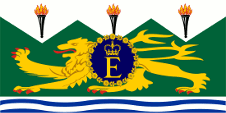 |
1961–1971, Flagge der Königin – flag of the Queen, Seitenverhältnis – ratio = 1:2, Quelle/Source, nach/by: Flags of the World |
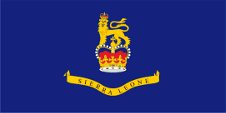 |
1961–1971, Flagge des Generalgouverneurs – flag of the Governor General, Seitenverhältnis – ratio = 1:2, Quelle/Source, nach/by: Flags of the World |
| Die heutige Flagge von Sierra Leone wurde am 27.04.1961 aus Anlass der Unabhängigkeit eingeführt. Sie zeigt drei waagerechte Streifen in Grün, Weiß und Blau. Die Farben stammen aus dem Wappen des Landes. Grün steht für die Landwirtschaft, den Naturreichtum und die Berge. Weiß steht für Einigkeit, Gerechtigkeit, Tugend und Frieden, Blau steht für das Meer und unterstreicht die wirtschaftliche Bedeutung des Hafens von Freetown. Über die genaue Definition der Farbtöne ist nichts bekannt, nur dass es sich um recht helle Farben handeln soll. Bezugnehmend auf ein Foto des Botschafters von Sierra Leone bein der UNO, dass neben der Landesfahne aufgenommen wurde, lässt sich sagen, dass die beim Druck dieser Flagge verwendeten Farben der folgenden Festlegung am nächsten kommen: Blau = pt 3005 c, Grün = pt 361 c. | The
today’s flag of Sierra Leone was introduced on 27th of April in 1961 on the
occasion of independence. It shows three horizontal stripes in green, white
and blue. The colours derive from the coat of arms of the
country. Green stands for the agriculture, the natural richness and the mountains. White stands for unity, justice, virtue and peace. Blue stands for the ocean and underlines the economic importance of the port of Freetown. Nothing is known about the exact definition of the colours, only that they are supposed to be quite light colours. Referring to a photo of Sierra Leone's ambassador to the UN taken next to the country's flag, it can be said that the colours used in printing this flag are closest to the following definition: Blue = pt 3005 c, Green = pt 361 c. |
| In der Flaggengeschichte des Landes weißt der Union Jack auf die früheren Verbindungen zu Großbritannien hin. | In the country's flag history, the Union Jack refers and points out to the former ties with United Kingdom. |
Großbritannien hatte in Jahr 1864 ein Flaggensystem eingeführt, in dem:
Seit 1865 durften Schiffe von Kolonialregierungen einen Blue Ensign mit einem Badge (Abzeichen) im fliegenden Ende führen. Die jeweiligen Regierungen sollten entsprechene Bagdes zur Verfügung stellen. Handelsschiffe und seefahrende Privatpersonen aus Kolonien dürfen nur dann einen Red Ensign mit Badge führen, wenn von der britischen Admiralität eine entsprechende Erlaubnis für die Kolonie erteilt wurde. |
United Kingdom introduced a flag system in 1864 in which:
Since 1865 ships of colonial governments were permitted to fly the Blue Ensign with a badge in the flying end of the flag. The respective governments were asked to design appropriate badges. Merchant ships and seafaring persons from colonies were only permitted to use the Red Ensign with a badge, then also named Civil Ensign, if permission has been given to the respective colony by the British admiralty. |
| Ein solches Badge war oft eine auf einer Scheibe platzierte regionale landschaftliche Darstellung, zeigte oft Schiffe, historische Begebenheiten oder konnte auch nur eine Art Logo sein. | Such a badge was often a regional scenic representation placed on a disc, often showed ships, historical incidents or could just be a kind of logo. |
| Das 1889 eingeführte Emblem (Badge) zeigte einen Elefanten mit drohender Gebärde vor einer Palme inmitten einer afrikanischen Landschaft. Unten auf dem Badge waren die Buchstaben "S.L." in Rot zu sehen. | The in 1889 introduced emblem (badge) showed an elephant with threatening gesture in front of a palm tree amid an African scenery. In the lower part of the badge were to see the letters "S.L." in red. |
| Im Jahre 1914 wurde ein neues Badge eingeführt. Es zeigte einen Schild, in dessen Schildhaupt der vor 1801 verwendete Union Jack zu sehen war. Das gespaltene Schild zeigte rechts eine Palme auf Gold und links einen am Meeresufer sitzenden in die Freiheit entlassenen schwarzen Sklaven der einem britischen Schiff hinterherwinkt. Unterhalb des Schildes, befand sich in einem silbernen Spruchband das damalige Motto des Landes: "AUSPICE BRITANNIA LIBER" → "Frei unter dem Schutz Britanniens". Dieses Badge wurde bis 1960 verwendet. | In 1914
was introduced a new badge. It showed a shield and in its head was to see
the until 1801 used Union Jack. The per pale divided shield showed on the right a palm tree on gold and to the left an on the shore sitting in the freedom freed black slave who beckons behind a British ship. Below the shield was placed in a silvery banner the then motto of the country: "AUSPICE BRITANNIA LIBER" → "Free under protection of Britannia". That Badge was in use until the year 1960. |
| An Land repräsentierten der einzelne Bürger und auch die Behörden ihren Status als Bürger oder Organe der britischen Nation, verkörpert im United Kingdom, durch die Verwendung des Union Jack, dann „Union Flag“ genannt. Zur See war somit für den britischen Bürger die britische Handelsflagge, der Red Ensign (Rote Flagge) vorgesehen. In einigen wenigen Fällen wurde den Bürgern einer Kolonie durch die Admiralität erlaubt, auf See einen eigenen Red Ensign mit dem Badge der Kolonie zu verwenden. Für Sierra Leone lag eine solche Erlaubnis jedoch nicht vor. |
On land, the individual
citizen and also the authorities represented their status as citizens or
organs of the British nation, embodied in the United Kingdom, through the
use of the Union Jack, then called the "Union Flag". At sea, the British citizen was thus provided with the British merchant flag, the Red Ensign. In a few cases, the citizens of a colony were allowed by the Admiralty to use their own Red Ensign with the colony's badge at sea. However, no such permission was available for Sierra Leone. |
| Quelle/Source: un.slmission.gov.sl, Die Welt der Flaggen, Flaggen und Wappen der Welt, Wikipedia (EN), Flags of the World, Flaggen Wappen Hymnen, Volker Preuß | |
Wappen – Coat of Arms: |
|
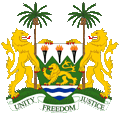 |
seit/since 1960, Wappen von Sierra Leone – coat of arms of Sierra Leone Quelle/Source, nach by: Corel Draw 4 |
 |
1889–1914, Emblem (Badge) von Sierra Leone – Badge of Sierra Leone, Quelle/Source, nach by: Flags of the World |
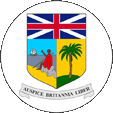 |
1914–1961, Emblem (Badge) von Sierra Leone – Badge of Sierra Leone, Quelle/Source, nach by: Flags of the World |
| Das Staatswappen wurde am 01.12.1960 von Königin Elisabeth II. verliehen. Es zeigt im Schildhaupt drei Fackeln auf Silber, in der Mitte einen goldenen Löwen auf Grün, und in der Schildspitze blaue Wellenlinien auf Silber. Schildhalter sind Löwen und Palmen. Unterhalb des Wappens ein silbernens Spruchband mit dem Motto des Landes: "Unity, Freedom, Justice" → "Einheit, Freiheit, Gerechtigkeit". Die drei Fackeln sind Symbole der Freiheit. Der Löwe weist auf den Landesnamen ("Löwengebirge") und die frühere britische Kolonialherrschaft hin. Die Wellenlinien repräsentieren das Meer. | The coat
of arms was awarded by Queen Elisabeth II. on 1st of December in 1960. It
shows in the head of the shield three torches on silver, in the middle a
golden lion on green and in the point of the shield blue wave lines on
silver. shield supporters are lions and palm trees. Below the scutcheon a silvery banner with the motto of the state: "Unity, Freedom, Justice". The three torches are symbols of freedom. The lion points out of the name of the country ("lion mountains") and the former British colonial reign. The wave lines represent the ocean. |
| Quelle/Source: Die Welt der Flaggen, Flaggen und Wappen der Welt, Wikipedia (EN), Flaggen Wappen Hymnen, Volker Preuß | |
Flugzeugkokarde – aircraft roundel: |
|
 |
Flugzeugkokarde – aircraft roundel Quelle/Source, nach/by: Wikipedia (EN) |
Landkarte – Map: |
Lage – Position: |
Landkarte des Landes – Map of the Country: |
|
|
| Zahlen und Fakten – Numbers and Facts: | |
|
|
|
|
|
|
|
|
|
|
|
|
|
|
|
|
|
|
|
Mittelalter · Besiedlung der Region des heutigen Sierra Leone durch das Volk
der Bulom 14.–15. Jahrhundert · Einwanderung der Völker der Krim, Gola, Mende und Temne 1462 · Entdeckung der Küste des heutigen Sierra Leone durch den portugiesischen Seefahrer Pedro de Cintra, er gibt dem Land den Namen "Serra da Leão", einige Jahre später wird durch die Portugiesen an der Küste der Sklavenhandelsstützpunkt Mitombo errichtet 1562 · Landung englischer Truppen, Vertreibung der Portugiesen, England übernimmt den gesamten Küstenhandel, im Hinterland erobert das Volk der Temne große Teile des Landes 1650 · Errichtung englischer Faktoreien 1787 · Philanthropen aus Großbritannien kaufen Land an der Küste von Sierra Leone um in Westindien freigelassene schwarze Sklaven hier anzusiedeln und einen Beitrag zur Abschaffung des Sklavenhandels zu leisten, Gründung der Stadt Freetown durch die Sierra Leone Society 1808 · das Küstenland von Sierra Leone wird britische Kronkolonie 1825 · Anschluss der Insel Sherbro und von Teilen des Hinterlands an die britische Kolonie 1866–1888 · Sierre Leone gehört zu Britisch Westafrika, den "West Africa Settlements" 1895–1896 · Grenzverträge mit Frankreich, Sierra Leone erreicht seine heutige Größe 1951 · neue Verfassung 1956 · allgemeine und freie Wahlen 1958 · Großbritannien gewährt Sierra Leone innere Selbstverwaltung 27.04.1961 · Großbritannien gewährt Sierra Leone die Unabhängigkeit als konstitutionelle Monarchie im Rahmen des Commonwealth of Nations 1967–1971 · diverse Militärputsche 19.04.1971 · Proklamation der Republik 1978 · Einführung des Einparteiensystems (APC-Partei) 1991 · der Bürgerkrieg im Nachbarland Liberia dehnt sich auf Sierra Leone aus, Wiedereinführung des demokratischen Mehrparteiensystems 1992 · Militärputsch unter V. Strasser 1996 · Militärputsch unter J. M. Bio 1996 · Friedensverhandlungen im Bürgerkrieg, Parlaments- und Präsidentschaftswahlen 1997 · Putsch durch die RUF-Miliz 1997 · Stationierung der Friedenstruppe ECOMOG 1999 · Waffenstillstandsabkommen, Stationierung einer UNO Friedenstruppe 2000 · Eingreifen britischer Truppen 2002 · Ende des Bürgerkriegs |
| Middle
Ages · settlement of the region of the today’s Sierra Leone by the people of
Bulom 14th–15th century · immigration of the peoples of Krim, Gola, Mende and Temne 1462 · discovery of the coast of the today’s Sierra Leone by the Portugese seafarer Pedro de Cintra, he names the country "Serra da Leão", some years later the Portugese establish near the coast the slave trading base Mitombo 1562 · debarkation of English troops, expulsion of the Portugese, England takes over the whole coastal trade, in the hinterland the peaople of Temne conquers large parts of the country 1650 · establishment of smaller English factories 1787 · Philanthropists from United Kingdom buy land at the coast of Sierra Leone to settle here in West India freed black slaves and to do a contribution to the abolition of the slave trading, foundation of Freetown by the Sierra Leone Society 1808 · the coastal region of Sierra Leone becomes a British crown colony 1825 · annexion of Sherbro Island and of parts of the hinterland by the British colony 1866–1888 · Sierre Leone is part of British West Africa, the "West Africa Settlements" 1895–1896 · frontier treaties with France, Sierra Leone reaches its today’s size 1951 · new constitution 1956 · common and free elections 1958 · United Kingdom grants Sierra Leone inner self administration 27th of April 1961 · United Kingdom grants Sierra Leone the independence as constitutional monarchy in the framework of the Commonwealth of Nations 1967–1971 · diverse military coups d’état 19th of April 1971 · proclamation of the republic 1978 · introduction of the single-party-system (APC-Party) 1991 · the civil war in the neighboring country Liberia extends to Sierra Leone, re-introduction of the democratic multi-party-system 1992 · military coup d’état under V. Strasser 1996 · military coup d’état under J. M. Bio 1996 · peace-negotiations in the civil war, elections for parliament and president 1997 · coup d’état by the RUF militia 1997 · deploy of the peace-unit ECOMOG 1999 · cease fire, deploy of an UNO peace-unit 2000 · intervention of British troops 2002 · end of the civil war |
| Quelle/Source: Atlas zur Geschichte, Wikipedia (D), World Statesmen |
| Als der portugiesische Seefahrer Pedro de Cintra und seine Begleiter im Jahre 1462 die heutige Halbinsel Sierra Leone erreichten und am dortigen Küstengebirge vorbeikamen, hielten sie das Heulen des Sturms im Gebirge für Löwengebrüll und nannten es deshalb "Serra da Leão", also "Löwengebirge". Die spanische(!) Entsprechung dieses Namens – Sierra Leone – setzte sich schließlich auch als Bezeichnung für das gesamte Hinterland durch. | As the
Portugese seafarer Pedro de Cintra and its companions in the year 1462
achieved the today’s Sierra Leone peninsula and passed the there coastal
mountains, they thought that the howl of the storm in the maountains is the
roaring of lions and they named it because of that "Serra da Leão", → "lion
mountains". The Spanish(!) equivalent of that name – Sierra Leone – achieved finally as denomination for the whole hinterland. |
| Quelle/Source: Handbuch der geographischen Namen | |